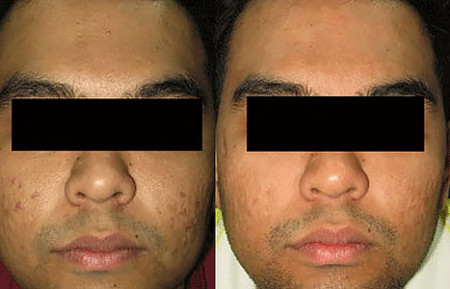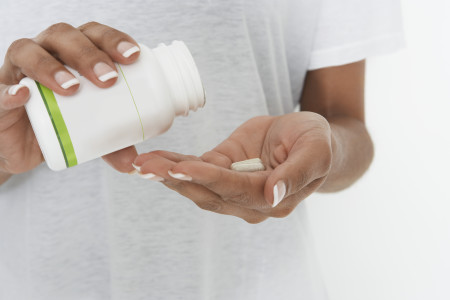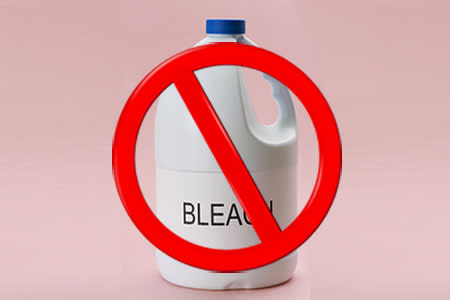
How To Fade Dark Spots In Skin Of Color
Have you tried treating dark spots on your own without getting the results you want? Do you constantly see new dark spots appear as others fade?
If you answered yes, you’re not alone. Darks spots and patches rank as one of the most common reasons that people with skin of color see a dermatologist.
Before and after treatment
His dermatologist used laser therapy and prescription-strength hydroquinone cream to clear the spots of color in 8 weeks.

Why dark spots and patches appear
People who have medium to darkly colored skin get dark spots and patches because something triggers their skin to make extra melanin, the substance that gives skin its color. Many everyday things can trigger extra melanin in people who have skin of color.
Dark spots and patches often appear when:
- A pimple or patch of psoriasis clears
- A wound caused by an insect bite, cut, burn, or other injury heals
- You take (or apply) certain medications
- A skin or hair care product irritates your skin
- Changes due to hormones occur, such as during pregnancy
If you treat a skin condition like acne or psoriasis so that you stop the flare-ups or breakouts, you’ll eliminate what’s causing the discoloration. Most dark spots will then fade on their own.
Likewise, if you find that a skin care product is causing the discoloration, switching to a gentle product that doesn’t irritate your skin can stop new dark spots from forming and allow existing spots to clear.
Could a medicine be causing your dark spots?
Don’t stop taking it. That could make you very sick. Ask the doctor who prescribed the medicine if discolored skin is a possible side effect. If it is, ask if you could switch to another medicine.

Fading can take time
Once you stop what’s causing the dark spots or patches, fading can take time. A spot that is a few shades darker than your skin will usually fade within 6 to 12 months.
If the color lies deep in your skin, however, fading can take years. Discoloration that lies deep in the skin is often slate blue to gray in color. It may also be brown, but the brown is much darker than your natural skin color.
Treatment can speed up fading of dark spots and patches.
Effective treatment begins with sunscreen
Whether you’re treating the dark spots on your own or seeing a dermatologist, sunscreen is essential. Used daily, even when it’s raining or snowing outdoors, sunscreen can prevent further darkening.
You’ll want to apply sunscreen to all skin that clothing won’t cover.
Sunscreen is essential to effective treatment
To get the protection you need, use a sunscreen that offers SPF 30 or higher, broad-spectrum protection, and zinc oxide or titanium dioxide.
If you have oily skin, look for the words “won’t clog pores” or “non-comedogenic.” This will help prevent breakouts, which could lead to more dark spots.

Skin-lightening products can speed up fading
Once you eliminate what’s causing the discoloration and protect your skin from sunlight, skin-lightening products tends to be more effective. You may have success with a product that you can buy without a prescription.
When choosing a skin-lightener, look for a product that contains one of the following ingredients:
- 2% hydroquinone
- Azelaic acid
- Glycolic acid
- Kojic acid
- Retinoid (retinol, tretinoin, adapalene gel, or tazarotene)
- Vitamin C
These ingredients can lighten existing spots. In some cases, the ingredient can also slow down production of melanin, which is what causes the dark spots and patches.
Some skin lighteners do more harm than good
When buying a skin-lightening product, you want to choose carefully. Some contain ingredients that can be very harmful to your skin and your health.
Researchers have found steroids or mercury, which weren’t listed on the product’s label, in skin lighteners from other countries.
The steroids in these products can cause pimples and rashes. If you unknowingly apply it to your skin for a long time, the steroids can cause thin and fragile skin or permanent discoloration.
To protect your health, you want to buy a skin-lightening product made in the United States or one recommended by your dermatologist.
Never use liquid bleach
Liquid bleach is a harmful treatment for removing dark spots and patches. You should never apply it to your skin.

How a dermatologist can help
If the treatment you’re using fails to deliver the results you want, you may want to see a dermatologist. Dark spots and patches can be a challenge to treat. To fade some, you need more than a skin lightener.
A dermatologist has the knowledge and expertise to safely combine treatments to help you get the best results.
Images Image 1: Used with permission of Journal of the American Academy of Dermatology: J Am Acad Dermatol. 2010;63:274-83.
Images 2-4: Getty Images
References Heath CR and Taylor SC. “Postinflammatory hyperpigmentation.” In: Kelly AP, Taylor SC. Dermatology for Skin of Color. McGraw Hill Medical, New York, 2009:337-340.
Manuskiatti W, Triwongwaranat D, et al. “Efficacy and safety of a carbon-dioxide ablative fractional resurfacing device for treatment of atrophic acne scars in Asians.” J Am Acad Dermatol. 2010;63(2):274-83.
Roberts WE. “Melasma.” In: Kelly AP, Taylor SC. Dermatology for Skin of Color. McGraw Hill Medical, New York, 2009:332-6.
Sources: https://www.aad.org/public/everyday-care/skin-care-secrets/routine/fade-dark-spots









